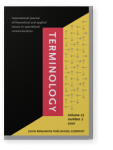Vol. 27:2 (2021) ► pp.294–321
e-DriMe
A Spanish-English frame-based e-dictionary about dried meats
Dried meats is an area that has not been widely studied from a terminological approach despite the growing need of Spanish companies to adapt data about their products into English to export their goods abroad. In this paper, we focus on the design and compilation of e-DriMe, a Spanish and English e-dictionary intended to assist to communicate effectively in the field of dried-meats. This e-dictionary is based on the principles of the Function Theory of Lexicography (Bergenholtz and Tarp 2002, 2003) and lexical semantics for terminology (L’Homme 2020). Firstly, the methodology to compile the e-dictionary is described, which relies on the content of a virtual Spanish-English comparable corpus of dried meat product cards. In addition, term extraction and entry tailoring are explained. Finally, some entries are exemplified. To summarize, we propose a new resource, e-DriMe, that can be easily integrated into computerized writing aids and computer-assisted translation tools.
Article outline
- 1.Introduction
- 2.Theoretical background
- 3.Design and compilation of a virtual comparable corpus as a terminological resource
- 3.1Corpus design
- 3.2Protocol for the compilation of C-GEFEM
- 3.2.1Locating and accessing resources
- 3.2.2Downloading and formatting
- 3.2.3Data storage
- 3.3Corpus features
- 3.3.1Availability
- 3.3.2Size
- 3.3.3Balance
- 3.3.4Representativeness
- 3.3.5The prospective user profile
- 4.The development of e-DriMe
- 4.1The selection of the terminology management system
- 4.2Term extraction
- 4.3The entry structure
- 4.4The design of frames
- 5.Examples
- 5.1Chorizo
- 5.2Pimentón
- 5.3Condimentar
- 5.4The frames
- 6.Conclusions
- Notes
-
References
